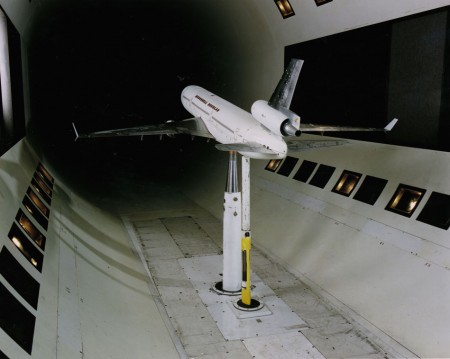
When most people watch a space shuttle launch, see footage of our battleships shooting rockets into terrorist hubs, or watch the 8:00 flight from London touch down on the runway, load cells are the last things on their minds. However, it is because of these little devices that aerospace technology is possible. Aside from load cells being vital parts to industrial weighing enterprises, these tiny tools are used in scientific testing for big names like NASA, Boeing, and Lockheed Martin. All three of these use one thing in common to test their products: wind tunnels, and wind tunnels use load cells to get accurate readings.
The wind tunnel
Imagine a large tube-shaped room or structure designed to sustain high-speed wind blasting through it, and you have a wind tunnel. These edifices serve the purpose to test how aerodynamic subjects are such as planes, rockets, cars and the components used to construct these objects.
Wind tunnels are equipped with load cells and other censors to calculate how the air flow transfers over, around, under and through the test subjects in the tunnel. Wind tunnels have saved people from death and injury because they eliminate the need for prototypes manned by people that are susceptible to crashing.
Depending on the wind tunnel balance, they can accommodate a wide variety of load cells. Kineoptics utilizes a very flexible open architecture design in that the basic isolation axis can be configured in multiple axes and with various thickness flexures as well as load cells that are suitable for many applications.
The science
Scientists and designers will attach the appropriate load cell type to the wind tunnel’s balance. As the wind speed increases pressure is applied to a direct point of contact while secondary points record changing pressure levels as the test subject rotates, or moves up and down and side to side. The load cells send the information to a transmitter that provides data to the research team. The majority of these are wireless load cell interfaces, and thanks to their implementation, we have sent probe droids and rovers to Mars in search of life.
Safety first
NASA has more wind tunnels than any other group on earth. Though wind tunnels can be used for various things, one of NASA’s primary tasks is to improve air transportation efficiency and safety. By putting a specialty modeled miniature scale aircraft in a wind tunnel, scientists can tell how to change a plane’s aerodynamic design to make it use less fuel, or to better maneuver out of strong and sudden bursts of wind. NASA can also test to see how changing the construction materials of a plane will impact its flight performance and safety standards.
Take your pick
You may not be a NASA scientist, but load cells are used in numerous industries, as well as in the home. One common type is a load cell for electronic scales. These devices can be found in doctor’s office’s, in factories, and some are even found inside the home garage. No matter what your project may be, load cells will make it easier.
